Agreed. Certainly not my bag of tea, but I can respect the direction he wanted to go. That's one of the great things in this hobby, lots of ways to do things.He posted a few pictures earlier. A more natural looking system which is perfectly fine in my opinion. You are not going to see skittles but you will see a full and lush garden from what I recall seeing last night.
Add in a few soft corals, pipefish, and other similar small fish I would say is icing on the cake in my opinion. I do not know what they keep personally but based on my diving I'd expect to see something like that with some sea grass, elegance, or clams mixed in. Maybe one big / large tang to scurry the smaller fish from time to time.
Navigation
Install the app
How to install the app on iOS
Follow along with the video below to see how to install our site as a web app on your home screen.
Note: This feature may not be available in some browsers.
More options
You are using an out of date browser. It may not display this or other websites correctly.
You should upgrade or use an alternative browser.
You should upgrade or use an alternative browser.
How do I get my zoas to grow nice and fat?
- Thread starter _pabloperetti
- Start date
- Tagged users None
U
User1
Guest
View BadgesAgreed. Certainly not my bag of tea, but I can respect the direction he wanted to go. That's one of the great things in this hobby, lots of ways to do things.
Yup - 100% agree with you. Have a great weekend!!!!
You, too!Yup - 100% agree with you. Have a great weekend!!!!
Zooxanthellae algae don't care about light sources - they only care about photons and energy values. Ask a marine biologist.
+ 1 on this comment!, and from experience I have tried it all (Halides, T5’s and all ranges of LED’s), and was able to obtain similar and successful results when used appropriately.
Further more, Zoas are considered amongst the easiest corals to house on a reef, in my personal opinion finding a light intensity that makes them comfortable (Not shriveled or over extended) and making sure they get their needed elements is the key... As an example, I’m taking the liberty to grab this photo bellow from one of my favorite zoa gardens, sustained by ReefRoids and fed twice a week, as per its owner and visible in it, some polyps are as big as his Acan heads...
So, for what is worth, focus on an intensity where they seem comfortable and make sure they are fed reasonably... Remember, it takes sometimes weeks for them to accommodate to changes, but once you find the equilibrium, your homework will be done and you will succeed in your own terms.
We are our own teachers, what works for others it may not be necessarily what works for you.
Best of luck
- Joined
- Dec 1, 2017
- Messages
- 249
- Reaction score
- 331
I came here to get some tips, but that's hardly what I saw.
I understand the natural vs LED debate but both sides seem pretty misrepresented.
Some people are great at making arguments, but beware of the loudest voice in the room.
From what I gathered, most sunlight/daylight tanks find corals grow Fuller and LED grow with more color. So if you want a full brown tank that you have to trim back let that light shine. You want a rainbow tank with some sparatic growth, LED is your cure.
I understand the natural vs LED debate but both sides seem pretty misrepresented.
Some people are great at making arguments, but beware of the loudest voice in the room.
From what I gathered, most sunlight/daylight tanks find corals grow Fuller and LED grow with more color. So if you want a full brown tank that you have to trim back let that light shine. You want a rainbow tank with some sparatic growth, LED is your cure.
Usable light is important. Doesn’t matter what manufacture of light one prefers, numbers don’t lie.
Lots of sources are available. There are side by side comparisons etc...
Go with what works for you.
Lots of sources are available. There are side by side comparisons etc...
Go with what works for you.
I have personally been culturing coral for over 20 years in coral farms, labs, indoor and outdoor grow operations, etc.
It is interesting to hear (see) a debate, and those being the loudest having zero to no proof to support their claims other than someone else’s YouTube videos.
I joined this forum to help, not to flame posts or ideas. This shouldn’t be a contest, it should be a collaborative community geared at helping hobbyist achieve successful results.
It is interesting to hear (see) a debate, and those being the loudest having zero to no proof to support their claims other than someone else’s YouTube videos.
I joined this forum to help, not to flame posts or ideas. This shouldn’t be a contest, it should be a collaborative community geared at helping hobbyist achieve successful results.
- Joined
- Feb 15, 2012
- Messages
- 4,729
- Reaction score
- 3,402
Do I have the loudest voice in the room? LOL!...
Some people are great at making arguments, but beware of the loudest voice in the room.
From what I gathered, most sunlight/daylight tanks find corals grow Fuller and LED grow with more color. So if you want a full brown tank that you have to trim back let that light shine. You want a rainbow tank with some sparatic growth, LED is your cure.
Sorry to say that you've got it wrong. Metal halide bulbs with lower ks will actually bring the real colors of the corals, just like in the ocean. LEDs, specially blue, will play more with the fluorescence reflection because of the quality of the blue they emit. We can use actinic blue fluorescent bulbs for that purpose too. Even the ATI Blue Plus T5 will give us a very nice reflective experience like that.
Lets hear Mr. Mike Palleta talking about Dr. Sanjay Joshi's tank under 6500K bulbs @10:46:
Halides are actually the best for colors!!
Too many myths and lies about proper lighting a reef tank.
It's ok to choose what we like, but it's better to lay down the facts here so we know the actual truth about it. Let people decide what they want, I agree.
Edit: The zoas in my tank show their true colors, like the ones from the reef. I don't have bright colored zoathids.
Last edited:
- Joined
- Feb 15, 2012
- Messages
- 4,729
- Reaction score
- 3,402
I just think we should know the real facts and not swallow any "LED ideas". Just like "halides ideas" too. They have different real properties and they won't change. One can't substitute the other. People are free to choose what they want. This is just a hobby. Seems like some of you guys are so defensive about the subject that you get a little upset. Relax... I had stopped posting, but some came up with more about it...I have personally been culturing coral for over 20 years in coral farms, labs, indoor and outdoor grow operations, etc.
It is interesting to hear (see) a debate, and those being the loudest having zero to no proof to support their claims other than someone else’s YouTube videos.
I joined this forum to help, not to flame posts or ideas. This shouldn’t be a contest, it should be a collaborative community geared at helping hobbyist achieve successful results.
People get too defensive when they use LEDs.
- Joined
- Feb 15, 2012
- Messages
- 4,729
- Reaction score
- 3,402
Please let me know what "paper" you are referring to....
Personally it doesn't matter what one uses but one shouldn't also state their way is the right way or only way to be healthy. There are aquaculture farms using LED's and Natural Sunlight land bound and successful with all corals. Ecotech did a study with their lighting - go read the paper.
What I do agree with you though is what regards to your zoa's colors and how they are also different in the wild. Acro, SPS, and other corals that hobbyist reference look different in the wild (I'm a scuba diver so see this all the time). So when I see a 500 dollar acropora with a name like homewrecker I shrug because there is no such scientific name of homewrecker nor is the color what it looks like in the natural environment.
But back to the OP I think you have some foundation to work with to grow Zoa's with the key being consistent with water parameters. That is pretty much the foundation for our tanks away is that consistency.
If you are talking about that nice PDF from Coral lab I know already.
They made so many mistakes there that it is a shame to publish.
How can they use those halides and T5s so high up and compare to their LEDs? Their LED fixtures actually work much better at that distance. T5s and halides weren't designed to be used so far from the water surface.
That PDF is a great marketing strategy. I applaud them for their smart move.
They made and are making lots of money. But hey, they are just doing their job.
I think we should stop posting about lighting to respect the OP's preferences.
Let's see other people post other things. Thanks.
Last edited:
Agreed, well said.I have personally been culturing coral for over 20 years in coral farms, labs, indoor and outdoor grow operations, etc.
It is interesting to hear (see) a debate, and those being the loudest having zero to no proof to support their claims other than someone else’s YouTube videos.
I joined this forum to help, not to flame posts or ideas. This shouldn’t be a contest, it should be a collaborative community geared at helping hobbyist achieve successful results.
- Joined
- Dec 14, 2018
- Messages
- 48
- Reaction score
- 45
Oh man!!!! How I hate to have to tell the truth sometimes...
I can't believe I'm the only one that comes here and writes this stuff!!!! LOL!
Ok, this video is a great example of what's going on nowadays in the market. They are teaching people what they believe and what they do. The wrong thing here is to take all that as an absolute truth and as the best thing one can offer to their system!
Some may think that what they say and do is actually the only and best way to go in keeping those poor polyps in a close system.
Those kids are mainly playing with zoanthid morphology and trying to "teach" as they were "doctors". They actually sound like "doctors". LOL! Sorry, just speaking my mind, boys. I'm actually not teasing them, but trying to express myself the best I can to define their tone when they speak. They sound knowledgeable, proud and important. Sorry boys, that's the truth! Anyways...
One can keep those same zoanthids, like I do, in the same tank with "high lights" and "lower Ks" and they ALL thrive 100%. Am I better than you guys? Am I better than them? No! If you use such low intensity and high cold spectrum, like those boys do, you will need to dance according to the music there!!! They probably do that to emphasize color reflection by the blue LEDs in order to claim their "colors" to sell. Guys... it's almost like black light!!! Almost every dealer is doing that, so it's a normal thing nowadays to be able to sell. They are just doing their job. Problem is that consumers will have to keep that "color" to have what they saw online or at the LFS. Do you think they find zoanthids in the wild under such type of illumination? Where? In caves? LOL! Show me pictures of those zoanthids in the wild under such light environment, please.
How does that work? Why are they still alive?
Simply explaining: they are just playing with those zoanthid's abilities to photo adaptation. Zoas have a tremendous ability to adapt to light, as we know. Many times we refer to that as a "morph". They change color to adapt to light. Is that the best way to keep those animals? Not in my opinion. If you ask a coral biologist he will probably say that some believe it could be taken as a form of abuse to those polyps because they weren't designed to live under such light environment. They can adapt to it, yes, but that's not the optimal. Should our goal as reefers be to reproduce and keep the optimal environment for what we keep? IMO the answer is absolutely yes. I know we are all different and this is just MY way to see it. I'm just talking about that "deep blue light" that many people like to keep for most of the day... The reflection makes the polyps look "great and colorful", but it's only reflection from those blue LEDs.
Terms like "big sizes = low light", "experimenting with light/flow", "People Eaters/ VitaminC", "Zoa-Paly types" sound very good and professional to the newbies, but are empty terms IMPOV, because all that means nothing, really. I know that's the way it is. It is very sad! Not flaming those boys at all. It's all over the place. That's what they've learned and they are just passing the best they know.
Because almost everyone in the hobby believes that is the very best light they can offer to their polyps as professionals, this hobby is simply perishing in that particular sense IMHO.
I'm judging the situation, not the boys. I believe they are sincere and really trust those words that came out of their mouths. They are good boys! They are successful in keeping those polyps under those circumstances too. Congratulations! That's all. If you agree with that concept than go ahead and do it. Be happy! This is just a hobby after all.
Truth is people can keep them under warmer spectrum and have much better results simply because about 90% of those polyps most likely came from very shallow waters exposed to air during low tide and can take 250W 6500K or 10000K halides showing their amazing natural coloration. So those so called "good tips" aren't absolute at all. This is the bottom line of this post.
Do you really think those colony structures are the best you can get out of those zoas? Don't make that mistake!
The majority, if not all, of those colonies are desperately gasping for light!
Can't you guys see that!? Look carefully and you will!
They are just playing with zoanthid's morphology, like many do. Just playing...
Again, we all have different way to see this hobby. This is the way I see.
Please don't take anything personal. This post is simply to expose the way I see after so many years keeping zoanthids. I too believe, like those boys, that I'm giving you the best advice I have! just a different experience. Hopefully I don't sound too much like a "doctor". LOL!!! If so, I'm sorry.
Enjoy the videos, my friends!
This video must be about 35 - 45 feet deep in an overcast day. T5s are great to resemble such environment!! People call this "windex color" as it would be a bad thing. One can resemble that environment during sunny days at that depth easily using 20K halide/ ATI Blue Plus T5s bulbs!
We can hardly find zoas there! Not impossible, but not like in shallower waters. Zoas prefer "extra shallow waters".
I gotta go back to work tomorrow, my friends...
Have a great weekend!
Very nice thread!!!! Keep zoaing!
Peace and God bless you all.
I love it. At least someone stay truth to what is real true natural color for what it is. Just like what a real model or actress before makeup and after make up, it's up to a individual preference how one would like to perceived. Absolutely brilliant write up.
- Joined
- Dec 14, 2018
- Messages
- 48
- Reaction score
- 45
I am a color specialist for commercial printing, traditional video and photographer that required understanding color theories so I know what the truth about color deviation and limit of these colors can reproduce.
There are few color gamuts that are using to reproduce whether paper, plastic, tv, monitor screen, corals... to reflect light to medium so human eyes can perceive.
We use CieLab, CMYK, RGB models to achieve the color reproduction from whatever medium we chose to perceived.
For now Led are quite advance for aquarium purpose but far from achieve what sunlight true spectrum.
All leds are using RGB model to recreate color spectrum to benefit coral growth and color boost but it has limit of how to create a true white or close to the Sun at noon has a natural color temp of 100 CRI and between 5000 and 5500 degrees Kelvin at noon time.
To the best of current led and base of RGB model, to replicate a simulate white color both RGB leds has to cross each other and converging become a slight tint yellowish white but it's far from true white compare to MH or T5 5-5.5K bulb.
As Led will be more advance as scientist discover way to emulate or simulate the sun true spectrum and it getting closer from new invention from KYOCERA. Using extra violet led to combine with RGB led to create broader spectrum that is very close to sunlight spectrum for first time.
What is true white led explain here https://onlinelibrary.wiley.com/doi/pdf/10.1002/opph.201400063
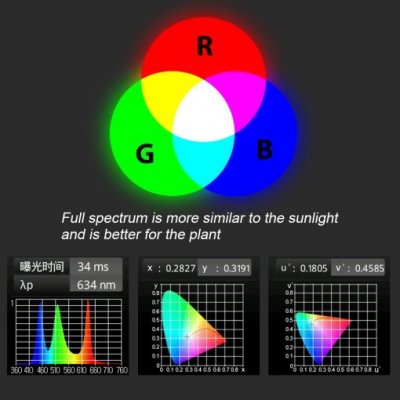
There are few color gamuts that are using to reproduce whether paper, plastic, tv, monitor screen, corals... to reflect light to medium so human eyes can perceive.
We use CieLab, CMYK, RGB models to achieve the color reproduction from whatever medium we chose to perceived.
For now Led are quite advance for aquarium purpose but far from achieve what sunlight true spectrum.
All leds are using RGB model to recreate color spectrum to benefit coral growth and color boost but it has limit of how to create a true white or close to the Sun at noon has a natural color temp of 100 CRI and between 5000 and 5500 degrees Kelvin at noon time.
To the best of current led and base of RGB model, to replicate a simulate white color both RGB leds has to cross each other and converging become a slight tint yellowish white but it's far from true white compare to MH or T5 5-5.5K bulb.
As Led will be more advance as scientist discover way to emulate or simulate the sun true spectrum and it getting closer from new invention from KYOCERA. Using extra violet led to combine with RGB led to create broader spectrum that is very close to sunlight spectrum for first time.
KYOCERA Develops World's First Full-Spectrum LED Aquarium Lighting; Innovative technology mimics sunlight at specific underwater depths; designed to optimize growth of corals and marine plants | News Releases | KYOCERA
Kyocera announced that the company developed the world’s first full-spectrum LED lighting for aquariums.
global.kyocera.com
What is true white led explain here https://onlinelibrary.wiley.com/doi/pdf/10.1002/opph.201400063

U
User1
Guest
View BadgesPlease let me know what "paper" you are referring to.
If you are talking about that nice PDF from Coral lab I know already.
They made so many mistakes there that it is a shame to publish.
How can they use those halides and T5s so high up and compare to their LEDs? Their LED fixtures actually work much better at that distance. T5s and halides weren't designed to be used so far from the water surface.
That PDF is a great marketing strategy. I applaud them for their smart move.
They made and are making lots of money. But hey, they are just doing their job.
I think we should stop posting about lighting to respect the OP's preferences.
Let's see other people post other things. Thanks.
Sure, let us do that. I will also be sure to sell my any stock(s) I own in LED technology on Monday and be sure to buy ATI's or similar bulb based company. Sounds like a lot of hobbyist and aquaculture farms will be trading tomorrow...
U
User1
Guest
View BadgesI am a color specialist for commercial printing, traditional video and photographer that required understanding color theories so I know what the truth about color deviation and limit of these colors can reproduce.
There are few color gamuts that are using to reproduce whether paper, plastic, tv, monitor screen, corals... to reflect light to medium so human eyes can perceive.
We use CieLab, CMYK, RGB models to achieve the color reproduction from whatever medium we chose to perceived.
For now Led are quite advance for aquarium purpose but far from achieve what sunlight true spectrum.
All leds are using RGB model to recreate color spectrum to benefit coral growth and color boost but it has limit of how to create a true white or close to the Sun at noon has a natural color temp of 100 CRI and between 5000 and 5500 degrees Kelvin at noon time.
To the best of current led and base of RGB model, to replicate a simulate white color both RGB leds has to cross each other and converging become a slight tint yellowish white but it's far from true white compare to MH or T5 5-5.5K bulb.
As Led will be more advance as scientist discover way to emulate or simulate the sun true spectrum and it getting closer from new invention from KYOCERA. Using extra violet led to combine with RGB led to create broader spectrum that is very close to sunlight spectrum for first time.
KYOCERA Develops World's First Full-Spectrum LED Aquarium Lighting; Innovative technology mimics sunlight at specific underwater depths; designed to optimize growth of corals and marine plants | News Releases | KYOCERA
Kyocera announced that the company developed the world’s first full-spectrum LED lighting for aquariums.global.kyocera.com
What is true white led explain here https://onlinelibrary.wiley.com/doi/pdf/10.1002/opph.201400063

Take DiCon for example - who picked up the lads from Berkeley / Kessil. If one thinks it is just for hobbyist they would be wrong. Medical, growing food, etc. Reef lighting is just a byproduct of their end game.
I think it is DiCon anyway that is the parent of Kessil. Never the less the lighting isn't made in a vacuum for pretty looking aquariums. Some of the lighting actually is based on scientific study and analysis. And this isn't even about Kessil - there are several other companies that are building LED kits with a purpose.
Heck, even a few of the DIY chips like Blue Acro actually do analysis with proto types to test what does, does not work. J
- Joined
- Dec 14, 2018
- Messages
- 48
- Reaction score
- 45
I simply state that Led technology is getting there but if you pay attention and look at RGB color gamut diagram then you will see there is limit what it can be achieve ATM. If you study color theory and I am sure all light manufacturers know about it when research and making their lighting products that know what the limitations.Take DiCon for example - who picked up the lads from Berkeley / Kessil. If one thinks it is just for hobbyist they would be wrong. Medical, growing food, etc. Reef lighting is just a byproduct of their end game.
I think it is DiCon anyway that is the parent of Kessil. Never the less the lighting isn't made in a vacuum for pretty looking aquariums. Some of the lighting actually is based on scientific study and analysis. And this isn't even about Kessil - there are several other companies that are building LED kits with a purpose.
Heck, even a few of the DIY chips like Blue Acro actually do analysis with proto types to test what does, does not work. J
It's not easy to replicate or even simulate full sunlight spectrum until now that a few companies like KYOCERA was able to research and able by combining violet LEDs and RGB phosphor blending technology, Kyocera's high-color-rendering LEDs produce light extremely close to natural sunlight. By customizing the spectrum, it reproduces the light close to that of the natural habitats of corals and water plants at specific underwater depths.
ATM all LED fixtures are focus more on the deeper spectrum in the range of 405-470 in their setting to get so called colourpop and ofcourse growth limit to this narrow range of this spectrum.
There is no dispute MH and T5 can growth corals faster than current LED technology available.
For colourpop of corals as we all know is just a matter of coral pigmentation react to certain light spectrum.
Is Led mimic close to full Sun light spectrum, not quite.
Can Led growth and stimulate color by react to certain color spectrum for the extra pop, ofcourse it can.
If we can not appreciate color just the way it is from natural light as nature intended then by all mean do so.
There is no wrong or right how each individual appreciate color by any mean.
Please look at those color charts and graphs of 4 major light manufacturers you can see and compare to full sunlight.
Look at KYOCERA spectrum chart you can see why it will be one of the led you would want.
You can only reduce and balance to certain custom intensity, par, spectrum of any light source provided it has mimic broad spectrum like the sunlight but you can not boost the spectrum that it does not have; unfortunately all current Led lack that capacity.
Who are we as a mere hobby argue with Professor and Scientists with current lighting sources, I quote these statement from research lab scientists.
Dr. Beatriz Estela Casareto, Professor at Research Institute of Green Science and Technology, Shizuoka University
“Whether corals can normally grow strongly depends on the health status of their symbiotic algae called zooxanthellae. As a result of their photosynthesis, zooxanthellae provide corals with essential organic matter that corals utilize for their growth. Light is a very important environmental factor that determines the photosynthetic performance of zooxanthellae and, therefore, the coral health status. At Shizuoka University, we had developed an experiment to test the abundance of zooxanthellae and their photosynthetic pigments (chlorophyll a and peridinin) in aquariums at 24℃, to test the effect of light on coral growth using Kyocera's Natural White's LEDs (KNW) and a conventional LED (CLED) at 400 µm cm-2 sec-1. The experiment was conducted for 2 months using two coral species, Montipora digitata and Acropora spp. from Okinawa. Results showed that corals incubated under KNW kept their original color intact against corals under CLED that appeared pale after 2 months. Zooxanthellae density increased 32 to 47%, Chl-a 17 to 44 % and peridinin 26 to 125% in KNW treatments when compared to CLED treatments. Results clearly showed that, due to its similarity to the natural sunlight, the KNW lamp is highly suitable for growing corals during a long period of time. It is also expected that, using KNW, new results in the study of coral physiological responses and coral bleaching will be obtained.”
Mr. Tetsuo Takeshima, Director of Enoshima Aquarium
“We had been looking for a high-quality light source alternative to metal-halide lamps since manufacturing and importing mercury products will be restricted from 2020 based on the Minamata Mercury Convention signed in 2013. It had been a big challenge for us because many sea water creatures cannot grow well with conventional LED lighting. We found Kyocera's LED lighting and tried using it for an experiment to raise eelgrass, which is difficult to grow with conventional LED, and this experiment showed positive results. We expect Kyocera's LED to drastically reduce power costs while creating a good environment for raising marine life.”
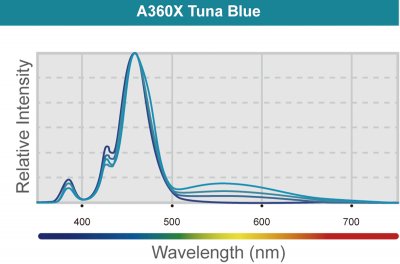
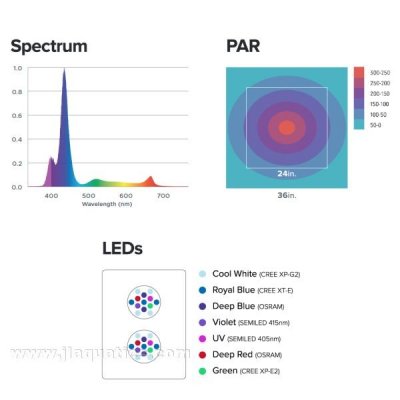
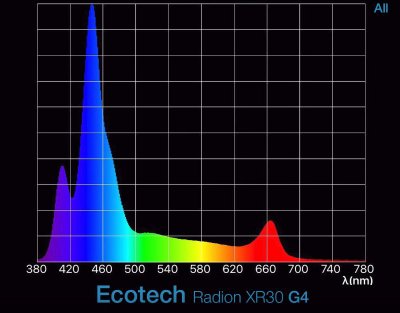
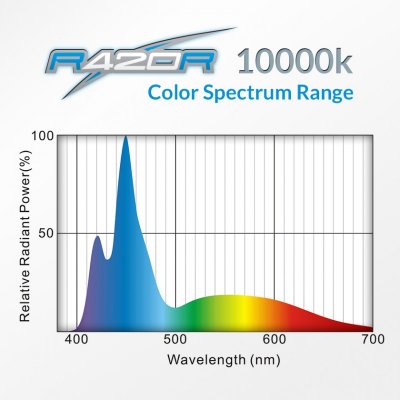
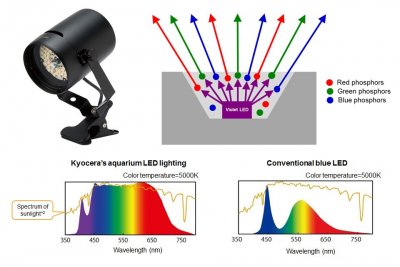
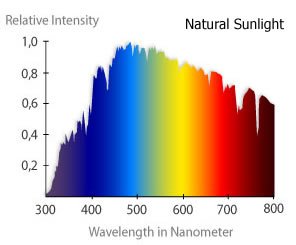
U
User1
Guest
View BadgesI simply state that Led technology is getting there but if you pay attention and look at RGB color gamut diagram then you will see there is limit what it can be achieve ATM. If you study color theory and I am sure all light manufacturers know about it when research and making their lighting products that know what the limitations.
It's not easy to replicate or even simulate full sunlight spectrum until now that a few companies like KYOCERA was able to research and able by combining violet LEDs and RGB phosphor blending technology, Kyocera's high-color-rendering LEDs produce light extremely close to natural sunlight. By customizing the spectrum, it reproduces the light close to that of the natural habitats of corals and water plants at specific underwater depths.
ATM all LED fixtures are focus more on the deeper spectrum in the range of 405-470 in their setting to get so called colourpop and ofcourse growth limit to this narrow range of this spectrum.
There is no dispute MH and T5 can growth corals faster than current LED technology available.
For colourpop of corals as we all know is just a matter of coral pigmentation react to certain light spectrum.
Is Led mimic close to full Sun light spectrum, not quite.
Can Led growth and stimulate color by react to certain color spectrum for the extra pop, ofcourse it can.
If we can not appreciate color just the way it is from natural light as nature intended then by all mean do so.
There is no wrong or right how each individual appreciate color by any mean.
Please look at those color charts and graphs of 4 major light manufacturers you can see and compare to full sunlight.
Look at KYOCERA spectrum chart you can see why it will be one of the led you would want.
You can only reduce and balance to certain custom intensity, par, spectrum of any light source provided it has mimic broad spectrum like the sunlight but you can not boost the spectrum that it does not have; unfortunately all current Led lack that capacity.
Who are we as a mere hobby argue with Professor and Scientists with current lighting sources, I quote these statement from research lab scientists.
Dr. Beatriz Estela Casareto, Professor at Research Institute of Green Science and Technology, Shizuoka University
“Whether corals can normally grow strongly depends on the health status of their symbiotic algae called zooxanthellae. As a result of their photosynthesis, zooxanthellae provide corals with essential organic matter that corals utilize for their growth. Light is a very important environmental factor that determines the photosynthetic performance of zooxanthellae and, therefore, the coral health status. At Shizuoka University, we had developed an experiment to test the abundance of zooxanthellae and their photosynthetic pigments (chlorophyll a and peridinin) in aquariums at 24℃, to test the effect of light on coral growth using Kyocera's Natural White's LEDs (KNW) and a conventional LED (CLED) at 400 µm cm-2 sec-1. The experiment was conducted for 2 months using two coral species, Montipora digitata and Acropora spp. from Okinawa. Results showed that corals incubated under KNW kept their original color intact against corals under CLED that appeared pale after 2 months. Zooxanthellae density increased 32 to 47%, Chl-a 17 to 44 % and peridinin 26 to 125% in KNW treatments when compared to CLED treatments. Results clearly showed that, due to its similarity to the natural sunlight, the KNW lamp is highly suitable for growing corals during a long period of time. It is also expected that, using KNW, new results in the study of coral physiological responses and coral bleaching will be obtained.”
Mr. Tetsuo Takeshima, Director of Enoshima Aquarium
“We had been looking for a high-quality light source alternative to metal-halide lamps since manufacturing and importing mercury products will be restricted from 2020 based on the Minamata Mercury Convention signed in 2013. It had been a big challenge for us because many sea water creatures cannot grow well with conventional LED lighting. We found Kyocera's LED lighting and tried using it for an experiment to raise eelgrass, which is difficult to grow with conventional LED, and this experiment showed positive results. We expect Kyocera's LED to drastically reduce power costs while creating a good environment for raising marine life.”






All fine and good - yet people have successful tanks with LED's. As I stated it doesn't matter to me what one uses.
My beef is when people say or insist that there is only one way.
- Joined
- Feb 15, 2012
- Messages
- 4,729
- Reaction score
- 3,402
Are you trying to provoke me to anger? LOL!Sure, let us do that. I will also be sure to sell my any stock(s) I own in LED technology on Monday and be sure to buy ATI's or similar bulb based company. Sounds like a lot of hobbyist and aquaculture farms will be trading tomorrow...
I was hoping for a better post than that, if you still want to keep talking about lighting, saf1.
Well, I would also hope they would change, truly, but everyone has their "deal" getting those LED fixtures for a better price (which is a huge marketing strategy IMO, through partnership, part of their jobs to keep rolling) and having their "energy saving vision" in order to avoid other better lighting technologies, choosing those LEDs. Many corals farmers have changed though and leaving their LEDs just for pictures in order to sell. Hope that comes to an end soon too!!
But don't be deceived, my friend! The best guys in the trade are actually still using the very best stuff over their coral farms: metal halides!!! Yes, the top sellers, in terms of quality (not necessarily numbers!!!!) are still using what's the best out there to grow their healthy corals. Want some healthy and true colorful corals?
Here:
Up above they have their halide systems!!!
@16:43
And here they are:
@17:25
Don't believe what you see? Give them a call and they will tell you what is the best to actually grow healthy colorful corals for the quality standard they want to offer!!!
Please don't compare them to others, like WWC, that actually needed to incorporate LEDs due to the lack of energy available to their wharehouse. (2012, per. comm.). I believe now it's too late for them to go back to halides. They have to honor the deal and be loyal to that LED company.
It's very interesting that you guys keep coming for more...
Good thing to expose some truth to the newbies!
Relax boys! The truth is only one and it's not going anywhere.
Watch that video (Tullio Dell Aquila) and you will see that not only spectrum compromises LEDs, but many other light qualities like for example proper constant intensity, spectrum blending, UV and IR! LEDs will never substitute halides. LEDs will never substitute T5s! And both of them will never substitute LEDs too. Choose what you want to and be happy. Just know they are different!
I apologize to the OP for so many lighting posts.
At the same time I know it's important to know that more than 60% of the healthy and color of the light loving corals, and zoanthids, you keep depend on optimal light for their natural functions of their metabolism. So this is all good to add to this thread anyways!
Enjoy your week.
Last edited:
- Joined
- Feb 15, 2012
- Messages
- 4,729
- Reaction score
- 3,402
Thanks again for your nice words and the substantial contribution to this thread!I love it. At least someone stay truth to what is real true natural color for what it is. Just like what a real model or actress before makeup and after make up, it's up to a individual preference how one would like to perceived. Absolutely brilliant write up.
I hope people appreciate your posts as I am!
- Joined
- Feb 15, 2012
- Messages
- 4,729
- Reaction score
- 3,402
I didn't see anyone here saying there is only one way yet.All fine and good - yet people have successful tanks with LED's. As I stated it doesn't matter to me what one uses.
My beef is when people say or insist that there is only one way.
Similar threads
- Replies
- 42
- Views
- 1,387
- Replies
- 9
- Views
- 266



















